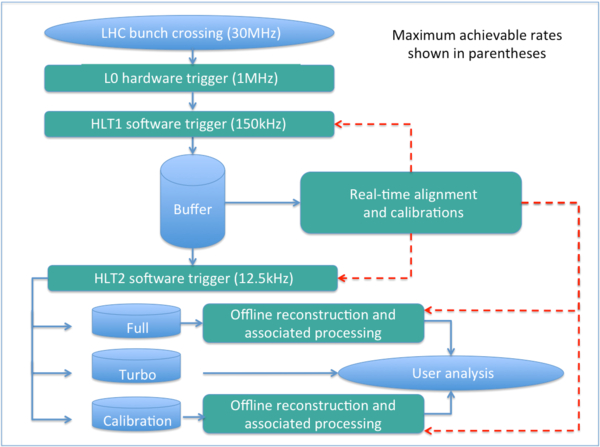Tesla : an application for real-time data analysis in High Energy Physics
[to restricted-access page]Information
LHCb-DP-2016-001
arXiv:1604.05596 [PDF]
(Submitted on 19 Apr 2016)
Comput. Phys. Commun. 208 35-42
Inspire 1449084
Tools
Abstract
Upgrades to the LHCb computing infrastructure in the first long shutdown of the LHC have allowed for high quality decay information to be calculated by the software trigger making a separate offline event reconstruction unnecessary. Furthermore, the storage space of the triggered candidate is an order of magnitude smaller than the entire raw event that would otherwise need to be persisted. Tesla, following the LHCb renowned physicist naming convention, is an application designed to process the information calculated by the trigger, with the resulting output used to directly perform physics measurements.
Figures and captions
|
Schematic diagram showing the overall data processing model in Run-II, where the blue solid line represents data flow, and the red dashed line the propagation of calibrations. |
Run2Sc[..].pdf [349 KiB] Thumbnail [343 KiB] |

|
|
Turbo data processing versus the traditional approach, as described in Section 4. The time taken for each step in hours is provided for a 3 GB raw data file. In addition, a calibration stream separates events for further processing to calculate data-driven efficiencies for both the Full and Turbo streams. |
Stream[..].pdf [279 KiB] Thumbnail [383 KiB] |

|
|
Comparison between variables calculated by the online and offline event reconstructions for the pion in $ D ^0 \rightarrow K ^- \pi ^+ $ decays of a single hour of LHCb data taking, where the colour represents the number of pion candidates. The variables are defined in the text. |
LucioH[..].pdf [14 KiB] HiDef png [100 KiB] Thumbnail [80 KiB] |

|
|
Steps required to save and restore trigger objects. |
reports1.pdf [188 KiB] Thumbnail [227 KiB] |

|
|
Structure of stored objects. Each top-level object represents a parent particle, which then points to child particles along with associated information. Note that the example shown is for a two-level particle decay. The infrastructure allows for as many levels as needed. |
reports2.pdf [111 KiB] Thumbnail [115 KiB] |

|
|
Method used to save and restore dynamic maps. |
dynamic.png [123 KiB] HiDef png [184 KiB] Thumbnail [67 KiB] |

|
|
Invariant mass distributions for candidates reconstructed in the $ K ^0_{\rm\scriptscriptstyle S} K ^- \pi ^+ \pi ^+ $ (a), $ K ^- K ^+ K ^+ $ (b), $ D ^0 (\rightarrow K ^- \pi ^+ )\pi ^+ $ (c), and $ K ^- K ^+ K ^+ $ (d) state hypotheses, from 26.5 $ pb^{-1}$ of proton collision data taken in 2015. The peaks corresponding to $ D ^+$ , $ D ^+_ s $ , and $ D ^{*+}$ mesons can clearly be seen. |
DspToK[..].pdf [24 KiB] HiDef png [129 KiB] Thumbnail [66 KiB] |

|
|
DspToKKK.pdf [23 KiB] HiDef png [130 KiB] Thumbnail [66 KiB] |

|
|
|
DstpToD0pi.pdf [23 KiB] HiDef png [111 KiB] Thumbnail [58 KiB] |

|
|
|
DpToKKK.pdf [23 KiB] HiDef png [137 KiB] Thumbnail [71 KiB] |

|
|
|
Possible LHCb Upgrade data processing model. |
upgrade.pdf [173 KiB] Thumbnail [223 KiB] |

|
|
Animated gif made out of all figures. |
DP-2016-001.gif Thumbnail |

|
Tables and captions
|
Rates of hadrons in Run I compared to the expected rate in the upgraded LHCb experiment [13]. |
Table_1.pdf [24 KiB] HiDef png [38 KiB] Thumbnail [17 KiB] tex code |

|
Created on 18 October 2023.
